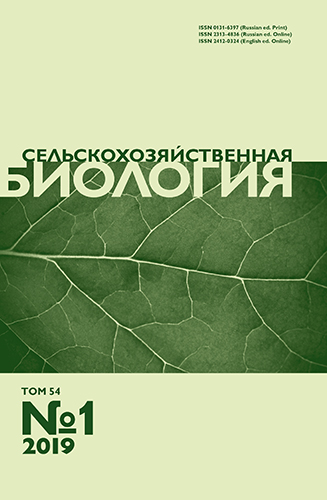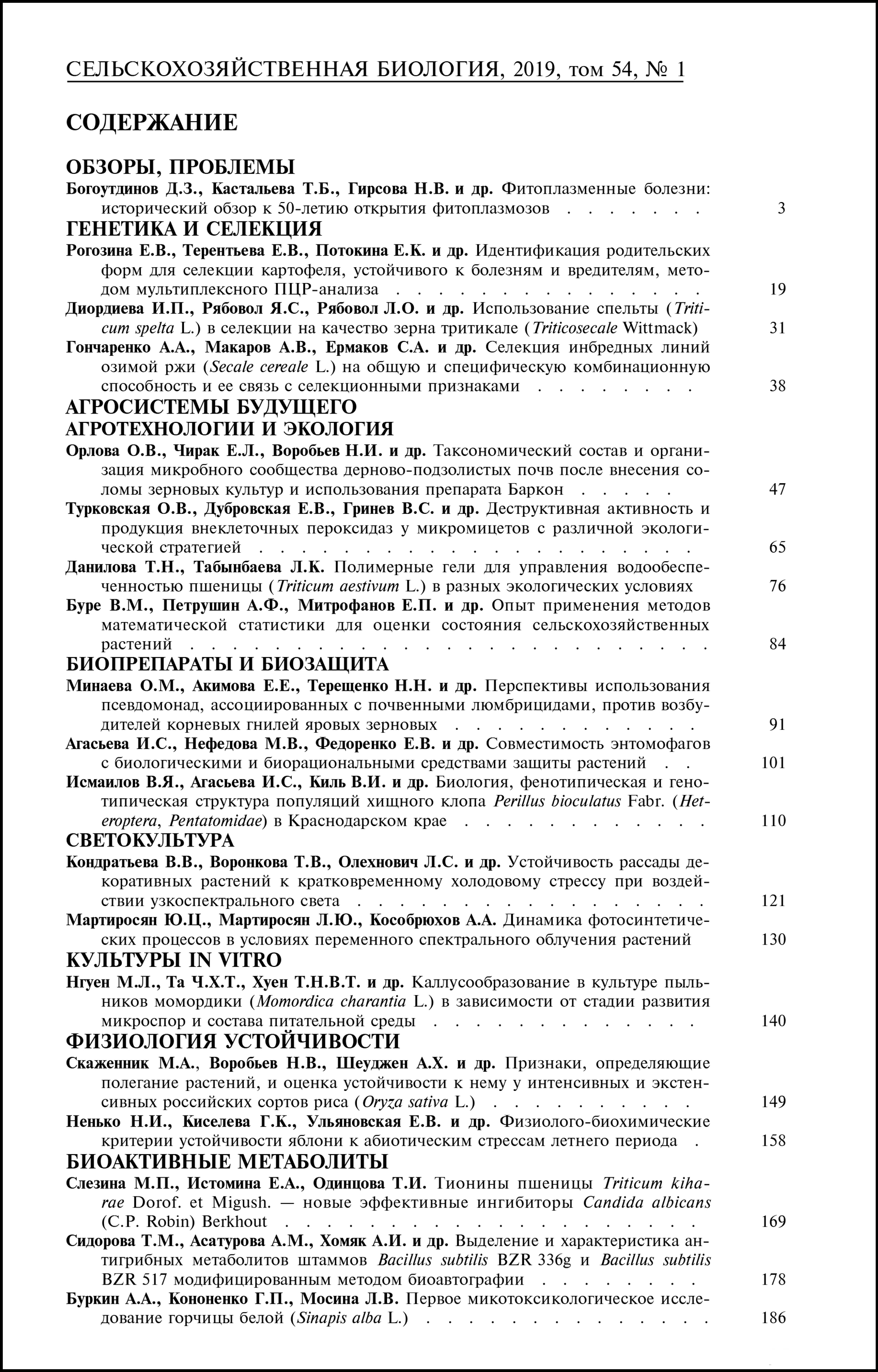doi: 10.15389/agrobiology.2019.1.65rus
УДК 579.64:579.222.2
Исследование выполнено при поддержке грантов РНФ № 16-14-00081 (в части деградации ПАУ) и РФФИ № 18-29-05062 (в части деградации нефти).
ДЕСТРУКТИВНАЯ АКТИВНОСТЬ И ПРОДУКЦИЯ ВНЕКЛЕТОЧНЫХ
ПЕРОКСИДАЗ У МИКРОМИЦЕТОВ С РАЗЛИЧНОЙ ЭКОЛОГИЧЕСКОЙ
СТРАТЕГИЕЙ
О.В. ТУРКОВСКАЯ, Е.В. ДУБРОВСКАЯ, В.С. ГРИНЕВ, С.А. БАЛАНДИНА,
Н.Н. ПОЗДНЯКОВА
Загрязнение окружающей среды природными и техногенными поллютантами остается серьезной проблемой. На сельскохозяйственные угодья попадают такие масштабные и опасные поллютанты, как нефть и полициклические ароматические углеводороды (ПАУ). Природные экосистемы имеют мощный детоксикационный потенциал, который обеспечивается деструктивной активностью микроорганизмов, в том числе аскомицетов — одной из самых многочисленных групп царства грибов. В настоящей работе мы впервые показали способность ряда ранее не изученных штаммов аскомицетов различной родовой принадлежности активно разрушать нефть и ПАУ, продуцируя внеклеточные пероксидазы. Нашей целью было изучение деградации нефти и полициклических ароматических углеводородов микромицетами с различной экологической стратегией, а также выявление лигнинолитических ферментов, участвующих в окислении этих поллютантов. Использовали четыре штамма аскомицетов — Fusarium oxysporum IBPPM543, Lecanicillium aphanocladii IBPPM542, Cladosporium herbarum MUT3238 и Geotrichum candidum MUT4803, имеющих различную таксономическую принадлежность и экологическую стратегию. Грибы культивировали в жидких средах различного состава с добавлением исследуемых полютантов — нефти, ПАУ, красителей антрахинонового типа. Через 14 сут с помощью газожидкостной хроматографии определяли убыль поллютантов и содержание основных продуктов их деградации. Активность лигнинолитических ферментов оценивали спектрофотометрически по скорости окисления соответствующих тестовых субстратов. У всех исследованных грибов выявлена нефтеокисляющая активность: утилизация нефти проходила на 46-82 % от исходной концентрации 5 г/л за 14 сут. C. herbarum MUT 3238 окислял все исследованные ПАУ (антрацен, фенантрен и флуорен) практически полностью (исходная концентрация 0,05 г/л). L. aphanocladii IBPPM 542 деградировал антрацен, фенантрен и флуорен соответственно на 40, 63 и 81 %, F. oxysporum IBPPM 543 окислял фенантрен и флуорен лишь на 20 и 40 %, G. candidum MUT4803 разрушал ПАУ не более чем на 18 %. Антрацен окислению не подвергался. Деградация поллютантов сопровождалась продукцией внеклеточных пероксидаз у всех грибов, за исключением G. candidum. Их активность в значительной степени стимулировалась ионами Mn2+. Следует отметить, что у C. herbarum и L. aphanocladii эти ферменты обнаружены нами впервые. Активность лигнин-пероксидаз и лакказ у исследованных грибов мы не обнаружили. Полученные результаты указывают на то, что представители двух широко распространенных в природе видов аскомицетов C. herbarum и F. oxysporum, а также штамм менее известного и мало изученного вида L. aphanocladii обладают деструктивным потенциалом в отношении нефти и ПАУ, что предполагает их участие в процессах самоочищения природы от этих поллютантов. Выявление лигнинолитических Mn-пероксидаз и соответствующих продуктов деградации ПАУ свидетельствует в пользу экологически целесообразного пути утилизации ПАУ, что снижает негативные последствия, связанные с возможным образованием токсичных метаболитов. У штамма G. candidum окисление нефти и ПАУ, вероятно, обусловлено активностью других ферментов, например цитохром Р450-монооксигеназы. Кроме того, велика вероятность наличия у этого штамматак называемойобесцвечивающей пероксидазы (dye-peroxidase), имеющей узкий субстратный спектр и катализирующей деградацию антрахиноновых красителей.
Ключевые слова: аскомицеты, Fusarium oxysporum, Lecanicillium aphanocladii, Cladosporium herbarum, биодеградация, полициклические ароматические углеводороды, нефть, лигнинолитические ферменты, пероксидазы.
O.V. Turkovskaya, E.V. Dubrovskaya, V.S. Grinev, S.A. Balandina,
N.N. Pozdnyakova
Environmental pollution by natural and man-made pollutants remains a serious problem. Agricultural areas are contaminated by major and hazardous pollutants such as oil, which comes from local oil-producing and oil-refining facilities, and polycyclic aromatic hydrocarbons (PAHs), which result from natural fires and from human activity associated with the use of flammable organic raw materials. This presents the hazard of accumulation of toxic substances in food and fodder plants. Natural ecosystems have powerful detoxifying potential, which is ensured by the degradative activity of microorganisms, including ascomycetes — one of the largest groups in the fungal kingdom. Here we examined the degradation of oil and PAHs by micromycetes with different ecological strategies and detected ligninolytic enzymes implicated in the oxidation of the pollutants. We used four ascomycete strains with different taxonomic affiliations and ecological strategies. These were Fusarium oxysporum IBPPM543, Lecanicillium aphanocladii IBPPM542, Cladosporium herbarum MUT3238, and Geotrichum candidum MUT4803. The fungi were grown in liquid media with different compositions that received additions of the pollutants used: oil, PAHs, and anthraquinone-type dyes. After 14 days of fungal growth, the elimination of the pollutants and the content of their main degradation products were examined by GC. Ligninolytic enzyme activity was estimated spectrophotometrically by the oxidation rate of the corresponding test substrates. All treatments in the experiments and analyses had no less than three replications, and each experiment was repeated no less than three times. Data were processed with Microsoft Excel 2003 software. All fungi oxidized oil; the utilization was from 46 to 82 % of the initial concentration of 5 g/l within 14 days. C. herbarum MUT 3238 metabolized all PAHs included in the study (anthracene, phenanthrene, and fluorene) almost completely (initial concentration, 0.05 g/l). L. aphanocladii IBPPM 542 degraded anthracene, phenanthrene, and fluorene by 40, 63, and 81 %, respectively. F. oxysporum IBPPM 543 utilized phenanthrene and fluorene only by 20 and 40 %, respectively. PAH degradation by G. candidum MUT4803 was not greater than 18 %. Anthracene was not degraded by F. oxysporum IBPPM 543 and G. candidum MUT4803. The degradation of the pollutants was accompanied by the production of extracellular peroxidases by all fungi except G. candidum. The activities of these peroxidases were largely stimulated by Mn2+; this property makes them similar to the Mn-peroxidases of basidiomycetes. This is the first report on the production of extracellular peroxidases by C. herbarum and L. aphanocladii. Neither of the fungi produced lignin peroxidase or laccase. Identification of the PAH oxidation products allowed us to suggest a pathway for PAH degradation by the tested fungi with an extracellular Mn-peroxidase. The degradation proceeds through the formation of quinones and carboxylic acids (phthalic and 2,2'-diphenic), which indicates that the PAHs are utilized almost completely and that no toxic metabolites accumulate. The obtained results indicate that two widely distributed ascomycete species, C. herbarum and F. oxysporum, and a strain of the lesser-known and poorly studied species L. aphanocladii, have degradative potential toward oil and PAHs, which presupposes their involvement in the self-cleaning of the environment from these pollutants. The detection of ligninolytic enzymes (Mn-peroxidases) and of the corresponding products of PAH degradation speaks in favor of an ecologically appropriate pathway for the utilization of PAHs, which reduces the negative consequences associated with the possible formation of toxic metabolites. In the G. candidum strain, the oxidation of oil and PAHs is possibly due to the activity of other enzymes, for example cytochrome Р450 monooxygenase, because no ligninolytic enzymes have been found. In addition, it is highly possible that this strain has a “dye peroxidase”, which requires a narrow range of substrates and catalyzes the degradation of anthraquinone dyes, as was also shown by us. The ability of all fungal strains to degrade pollutants makes them promising candidates for practical use in bioremediation and other biotechnologies.
Keywords: ascomycetes, Fusarium oxysporum, Lecanicillium aphanocladii, Cladosporium herbarum, biodegradation, polycyclic aromatic hydrocarbons, oil, ligninolytic enzymes, peroxidases.
ФГБУН Институт биохимии и физиологии растений |
Поступила в редакцию |












